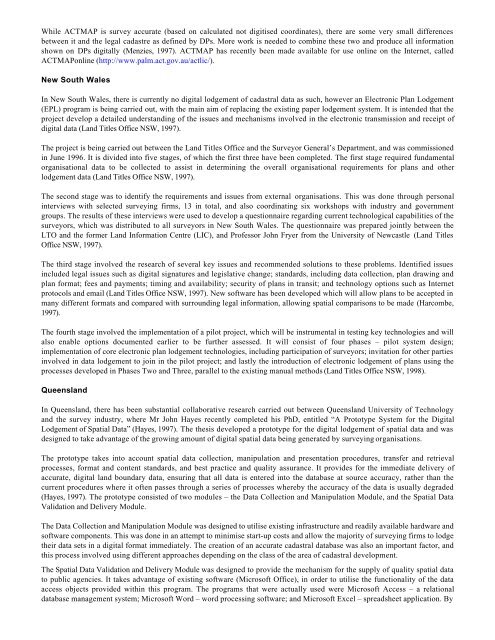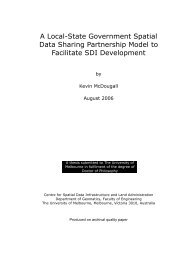Digital Lodgement of Cadastral Survey Data in Australia - Centre for ...
Digital Lodgement of Cadastral Survey Data in Australia - Centre for ...
Digital Lodgement of Cadastral Survey Data in Australia - Centre for ...
You also want an ePaper? Increase the reach of your titles
YUMPU automatically turns print PDFs into web optimized ePapers that Google loves.
While ACTMAP is survey accurate (based on calculated not digitised coord<strong>in</strong>ates), there are some very small differences<br />
between it and the legal cadastre as def<strong>in</strong>ed by DPs. More work is needed to comb<strong>in</strong>e these two and produce all <strong>in</strong><strong>for</strong>mation<br />
shown on DPs digitally (Menzies, 1997). ACTMAP has recently been made available <strong>for</strong> use onl<strong>in</strong>e on the Internet, called<br />
ACTMAPonl<strong>in</strong>e (http://www.palm.act.gov.au/actlic/).<br />
New South Wales<br />
In New South Wales, there is currently no digital lodgement <strong>of</strong> cadastral data as such, however an Electronic Plan <strong>Lodgement</strong><br />
(EPL) program is be<strong>in</strong>g carried out, with the ma<strong>in</strong> aim <strong>of</strong> replac<strong>in</strong>g the exist<strong>in</strong>g paper lodgement system. It is <strong>in</strong>tended that the<br />
project develop a detailed understand<strong>in</strong>g <strong>of</strong> the issues and mechanisms <strong>in</strong>volved <strong>in</strong> the electronic transmission and receipt <strong>of</strong><br />
digital data (Land Titles Office NSW, 1997).<br />
The project is be<strong>in</strong>g carried out between the Land Titles Office and the <strong>Survey</strong>or General’s Department, and was commissioned<br />
<strong>in</strong> June 1996. It is divided <strong>in</strong>to five stages, <strong>of</strong> which the first three have been completed. The first stage required fundamental<br />
organisational data to be collected to assist <strong>in</strong> determ<strong>in</strong><strong>in</strong>g the overall organisational requirements <strong>for</strong> plans and other<br />
lodgement data (Land Titles Office NSW, 1997).<br />
The second stage was to identify the requirements and issues from external organisations. This was done through personal<br />
<strong>in</strong>terviews with selected survey<strong>in</strong>g firms, 13 <strong>in</strong> total, and also coord<strong>in</strong>at<strong>in</strong>g six workshops with <strong>in</strong>dustry and government<br />
groups. The results <strong>of</strong> these <strong>in</strong>terviews were used to develop a questionnaire regard<strong>in</strong>g current technological capabilities <strong>of</strong> the<br />
surveyors, which was distributed to all surveyors <strong>in</strong> New South Wales. The questionnaire was prepared jo<strong>in</strong>tly between the<br />
LTO and the <strong>for</strong>mer Land In<strong>for</strong>mation <strong>Centre</strong> (LIC), and Pr<strong>of</strong>essor John Fryer from the University <strong>of</strong> Newcastle (Land Titles<br />
Office NSW, 1997).<br />
The third stage <strong>in</strong>volved the research <strong>of</strong> several key issues and recommended solutions to these problems. Identified issues<br />
<strong>in</strong>cluded legal issues such as digital signatures and legislative change; standards, <strong>in</strong>clud<strong>in</strong>g data collection, plan draw<strong>in</strong>g and<br />
plan <strong>for</strong>mat; fees and payments; tim<strong>in</strong>g and availability; security <strong>of</strong> plans <strong>in</strong> transit; and technology options such as Internet<br />
protocols and email (Land Titles Office NSW, 1997). New s<strong>of</strong>tware has been developed which will allow plans to be accepted <strong>in</strong><br />
many different <strong>for</strong>mats and compared with surround<strong>in</strong>g legal <strong>in</strong><strong>for</strong>mation, allow<strong>in</strong>g spatial comparisons to be made (Harcombe,<br />
1997).<br />
The fourth stage <strong>in</strong>volved the implementation <strong>of</strong> a pilot project, which will be <strong>in</strong>strumental <strong>in</strong> test<strong>in</strong>g key technologies and will<br />
also enable options documented earlier to be further assessed. It will consist <strong>of</strong> four phases – pilot system design;<br />
implementation <strong>of</strong> core electronic plan lodgement technologies, <strong>in</strong>clud<strong>in</strong>g participation <strong>of</strong> surveyors; <strong>in</strong>vitation <strong>for</strong> other parties<br />
<strong>in</strong>volved <strong>in</strong> data lodgement to jo<strong>in</strong> <strong>in</strong> the pilot project; and lastly the <strong>in</strong>troduction <strong>of</strong> electronic lodgement <strong>of</strong> plans us<strong>in</strong>g the<br />
processes developed <strong>in</strong> Phases Two and Three, parallel to the exist<strong>in</strong>g manual methods (Land Titles Office NSW, 1998).<br />
Queensland<br />
In Queensland, there has been substantial collaborative research carried out between Queensland University <strong>of</strong> Technology<br />
and the survey <strong>in</strong>dustry, where Mr John Hayes recently completed his PhD, entitled “A Prototype System <strong>for</strong> the <strong>Digital</strong><br />
<strong>Lodgement</strong> <strong>of</strong> Spatial <strong>Data</strong>” (Hayes, 1997). The thesis developed a prototype <strong>for</strong> the digital lodgement <strong>of</strong> spatial data and was<br />
designed to take advantage <strong>of</strong> the grow<strong>in</strong>g amount <strong>of</strong> digital spatial data be<strong>in</strong>g generated by survey<strong>in</strong>g organisations.<br />
The prototype takes <strong>in</strong>to account spatial data collection, manipulation and presentation procedures, transfer and retrieval<br />
processes, <strong>for</strong>mat and content standards, and best practice and quality assurance. It provides <strong>for</strong> the immediate delivery <strong>of</strong><br />
accurate, digital land boundary data, ensur<strong>in</strong>g that all data is entered <strong>in</strong>to the database at source accuracy, rather than the<br />
current procedures where it <strong>of</strong>ten passes through a series <strong>of</strong> processes whereby the accuracy <strong>of</strong> the data is usually degraded<br />
(Hayes, 1997). The prototype consisted <strong>of</strong> two modules – the <strong>Data</strong> Collection and Manipulation Module, and the Spatial <strong>Data</strong><br />
Validation and Delivery Module.<br />
The <strong>Data</strong> Collection and Manipulation Module was designed to utilise exist<strong>in</strong>g <strong>in</strong>frastructure and readily available hardware and<br />
s<strong>of</strong>tware components. This was done <strong>in</strong> an attempt to m<strong>in</strong>imise start-up costs and allow the majority <strong>of</strong> survey<strong>in</strong>g firms to lodge<br />
their data sets <strong>in</strong> a digital <strong>for</strong>mat immediately. The creation <strong>of</strong> an accurate cadastral database was also an important factor, and<br />
this process <strong>in</strong>volved us<strong>in</strong>g different approaches depend<strong>in</strong>g on the class <strong>of</strong> the area <strong>of</strong> cadastral development.<br />
The Spatial <strong>Data</strong> Validation and Delivery Module was designed to provide the mechanism <strong>for</strong> the supply <strong>of</strong> quality spatial data<br />
to public agencies. It takes advantage <strong>of</strong> exist<strong>in</strong>g s<strong>of</strong>tware (Micros<strong>of</strong>t Office), <strong>in</strong> order to utilise the functionality <strong>of</strong> the data<br />
access objects provided with<strong>in</strong> this program. The programs that were actually used were Micros<strong>of</strong>t Access – a relational<br />
database management system; Micros<strong>of</strong>t Word – word process<strong>in</strong>g s<strong>of</strong>tware; and Micros<strong>of</strong>t Excel – spreadsheet application. By







